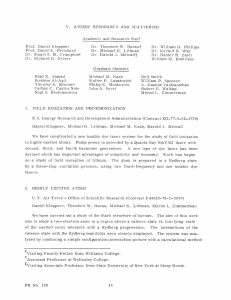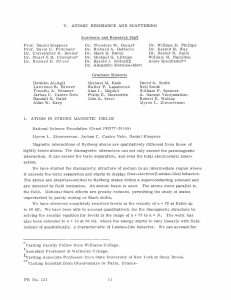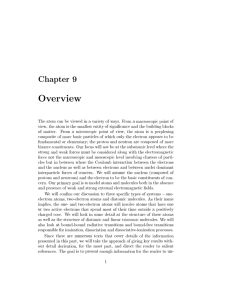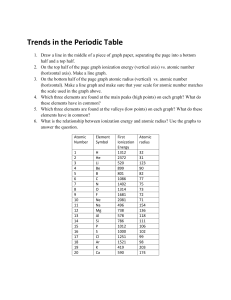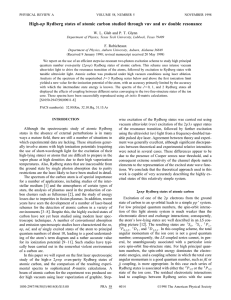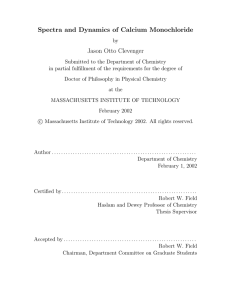V. ATOMIC RESONANCE AND SCATTERING
advertisement
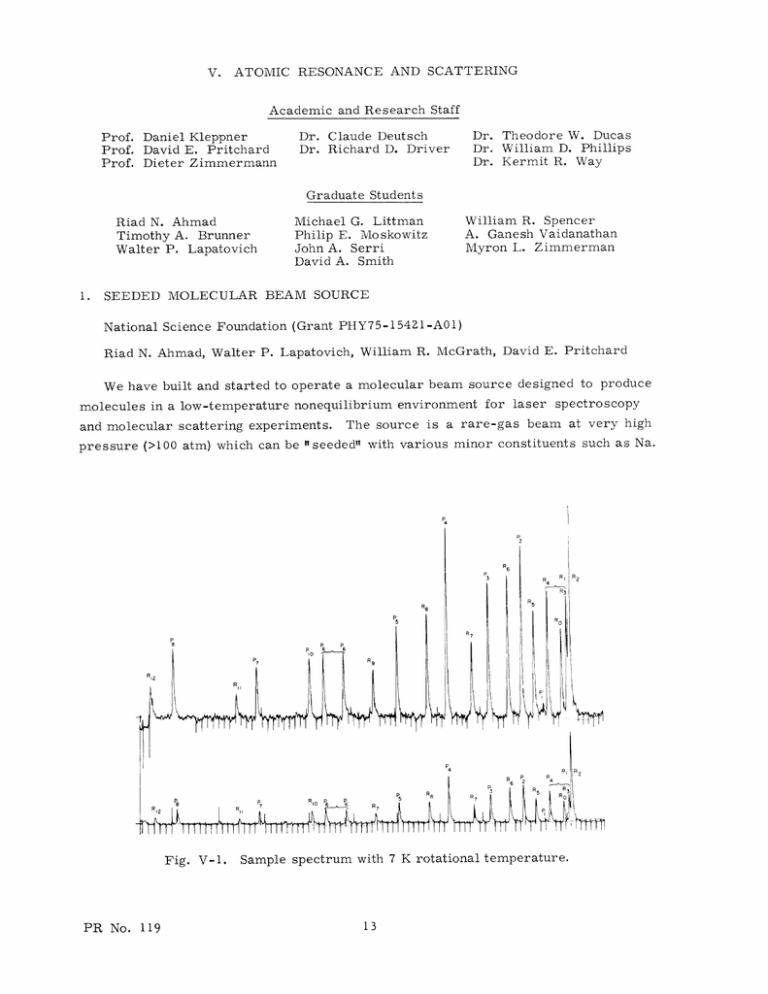
V. ATOMIC RESONANCE AND SCATTERING Academic and Research Staff Dr. Theodore W. Ducas Dr. William D. Phillips Dr. Kermit R. Way Dr. Claude Deutsch Dr. Richard D. Driver Prof. Daniel Kleppner Prof. David E. Pritchard Prof. Dieter Zimmermann Graduate Students Riad N. Ahmad Timothy A. Brunner Walter P. Lapatovich William R. Spencer A. Ganesh Vaidanathan Myron L. Zimmerman Michael G. Littman Philip E. Moskowitz John A. Serri David A. Smith 1. SEEDED MOLECULAR BEAM SOURCE National Science Foundation (Grant PHY75-15421-A01) Riad N. Ahmad, Walter P. Lapatovich, William R. McGrath, David E. Pritchard We have built and started to operate a molecular beam source designed to produce molecules in a low-temperature nonequilibrium environment for laser spectroscopy and molecular scattering experiments. pressure (>100 atm) which can be Fig. V-l. PR No. 119 " The source is seeded " a rare-gas beam at very high with various minor constituents such as Na. Sample spectrum with 7 K rotational temperature. (V. ATOMIC RESONANCE AND SCATTERING) We have succeeded in producing NaNe molecules which are bound by only ~0. 002 eV, and have observed several rotational bands of this molecule. We also have observed Na 2 bands with very low rotational temperatures. A sample spectrum with 7 K rota- tional temperature is shown in Fig. V-l. 2. ROTATIONAL ENERGY TRANSFER MEASUREMENTS WITH VELOCITY-SELECTED MOLECULES U. S. Air Force - Office of Scientific Research (Grant AFOSR 76-2972) David E. Pritchard, Richard D. Driver, Timothy A. Brunner, Neil Smith We are studying the processes of rotational energy transfer for Na 2 molecules in collision with Ar atoms. By using the VSDS technique proposed by Phillips and Pritchard,1 we shall measure the velocity-dependent cross sections of the collision process, Na 2 (v, J) + Ar = NaZ(v, J±AJ) + Ar + AE, where (v, J) are the vibrational-rotational quantum numbers of the molecular initial state. In July 1976 we received Model 599 cw dye laser. the first commercially 2 Radiation The Na 2 molecules are produced in Approximately 10% of the sodium vapor is in molecular form. The laser and oven are both working satisfactorily. the Na Coherent This has a single-mode output bandwidth of less than 10 MHz and is continuously tunable over a 30-GHz range. a stainless-steel oven. available We have made a detailed study of rotational-vibrational spectrum in the 610 mm wavelength region by observing the total fluorescent light signals as we scan the input laser beam into the oven. We have selected a number of lines in the total fluorescence spectrum and observed the wavelength dependence of their fluorescence with a scanning monochromator. Using such a spectrum and available published molecular constants for Na 2 , we have been able to designate (v,J) quantum numbers for the upper and lower energy levels of the transitions. We have observed collisionally induced, pressure-dependent satellites in the wavelength-dependent fluorescence spectrum corresponding to the rotational energy transfer processes of interest, and shall continue to study these processes. Data acquisition is carried out with the aid of a PDP-11 computer. The detection system is buffered into the computer via a CAMAC molecular system. Computer programs have been written to collect and reduce the experimental data. The preliminary work has shown that the system is working satisfactorily. References 1i. W. D. Phillips and D. E. Pritchard, "Velocity Selection by Doppler Shift: A General Method for Studying Excited-State Collisions," Phys. Rev. Letters 33, 12541257 (1974). PR No. 119 (V. 3. ATOMIC RESONANCE AND SCATTERING) OPTICAL FREQUENCY STANDARDS Joint Services Electronics Program (Contract DAAB07-76-C-1400) Walter P. Lapatovich, Philip E. Moskowitz, Kurt W. Offner, Abel Weinrib, David E. Pritchard The Mark I optical-frequency reference marks shown in Fig. V-2. system was used to make the frequency A new Mark II optical-frequency reference system has been designed and a prototype has been tested. It will provide continuous fast read-out of the frequency so that it can be used to servo-control the laser frequency. The device will also be interfaced to a computer. LASER SERVO STABILIZER OPTICS AND TO SERVO MIRROR MOUNT FRESNELRHOMB OPTIC AXIS PHOTODIODE ANALYZING POLARIZER 144 QUARTZ CRYSTAL ELECTRONICS d c MOTOR TO COMPUTER Fig. V-2. Optical-frequency reference system. The heart of the new system is an optical interferometer that rotates the linear polarization of the incident laser light by an amount proportional to its frequency; in the device under construction the rotation is 10 for each ~600 MHz increase in frequency. This interferometer has a linear polarizer, a birefringent element (a quartz crystal is used in the prototype) whose optic axis is shifted 450 with respect to the polarizer, a quarter-wave plate set with its optic axis parallel to the polarizer, and an automated sensor for finding the angle of polarization. This device functions as follows: Two orthogonally linearly polarized light beams with a relative phase delay proportional to the frequency are produced by the birefringent element. into oppositely PR No. 119 rotating circularly These beams are converted polarized light beams by the quarter-wave plate, (V. ATOMIC RESONANCE AND SCATTERING) and they interfere to give a linearly polarized beam whose angle increases linearly with the phase delay. This angle is then converted into electrical information suitable for controlling or indicating the frequency. 4. SUBMILLIMETER PHOTON COUNTING Joint Services Electronics Program (Contract DAAB07-76-C-1400) Daniel Kleppner, Myron L. Zimmerman, Michael G. Littman We have started to develop a new technique for detecting millimeter and submillimeter radiation, using a gas of highly excited atoms as the working medium. Resonance transitions are induced between suitably chosen levels, and detected by field ionization of the final state. Under certain conditions, the system gives promise of allowing efficient and quiet photon counting in the millimeter and submillimeter ranges. Continuous tuning is possible by using the first-order Stark effect. Experimental work includes construction of a CO 2 10 p.m laser, and of a CH3F pim laser for use as spectral sources. Resonance transitions have been detected at 10 pm. Calculations of transition moments for Stark-shifted levels are in progress. 496 5. STUDIES IN OPTICAL PHYSICS AND EXCITED-STATE INTERACTIONS Joint Services Electronics Program (Contract DAAB07-76-C-1400) Theodore W. Ducas, William R. Spencer, A. Ganesh Vaidanathan, Daniel Kleppner New methods for exciting atoms to high Rydberg states are needed in a variety of and for practical applications. We have undertaken the cw excitation of experiments Rydberg states in an atomic beam, using two-photon transitions and single-photon transitions with frequency-doubled light. The frequency-doubling system has been brought into operation, and a new atomic beam apparatus has been constructed. This apparatus is designed to allow motion of Rydberg atoms from an excitation region to interaction and detection regions. The system should soon be fully operable. 6. THEORETICAL STUDY OF ATOMIC RYDBERG STATES Joint Services Electronics Program (Contract DAAB07-76-C-1400) Claude Deutsch In order to lend theoretical support to the experimental study of the Rydberg states of light elements and alkalies undertaken by Daniel Kleppner and his co-workers, we PR No. 119 (V. ATOMIC RESONANCE AND SCATTERING) have reconsidered and generalized the polarization model determination of the highly 1 and obtained nonlocated hydrogenic levels. First, we considered neutral helium, 7 - 6 polarization potential. The extension of this and R adiabatic corrections to the R result to the alkalies by retaining the fine-structure term in the zero-order approximation is straightforward. We have also studied the behavior of hydrogen Rydberg states in the presence of a magnetic field so strong that perturbation theory is no longer valid. This problem has been approached by factorizing the nonrelativistic wave function into a product of a two-dimensional harmonic oscillator and a one-dimensional coulomb hydrogen atom. Extensions of this basic scheme to allow for the inclusion of magnetic intensities of any intermediate value are now being investigated. References 1. C. Deutsch, "Rydberg States of HeI Using the Polarization Model," Phys. Rev. A 13, 2311-2313 (1976). 7. FIELD IONIZATION U. S. Air Force - Office of Scientific Research (Contract F44620-72-C-0057) Michael G. Littman, Daniel Kleppner The problem of finding out how an atom ionizes in an applied electric field has received much attention for several years, and now the theory for hydrogen is well developed. We have carried out the first precise study of field ionization by measuring ionization rates for highly excited states of sodium. We have obtained excellent agreement with hydrogenic theory for some states, but the ionization rates are in serious disagreement for most states. The source of the disagreement was found to be the effects of level mixing that had been neglected previously. The problem is of theoret- ical interest and of considerable practical importance because field ionization is widely used for detecting highly excited atoms. Further details of this work have been published recently. 1 References 1. M. G. Littman, M. L. Zimmerman, and D. Kleppner, "Tunneling Rates for Excited States of Sodium in a Static Electric Field," Phys. Rev. Letters 37, 486-489 (1976). PR No. 119 (V. 8. ATOMIC RESONANCE AND SCATTERING) ATOMS IN VERY HIGH MAGNETIC FIELDS National Science Foundation (Grant PHY75-15421-A01) Myron L. Zimmerman, Daniel Kleppner The effect of magnetic fields on atoms is usually so weak that it can be treated as a first-order perturbation. At high fields diamagnetic terms become important. The 22 2 interaction is of the form 3 Cd = e B (x +y 2 )/8mc 2 . The diamagnetic energy WB scales as (r ) B Z. For an atom in a Rydberg state (a highly excited state), ( r ) n is the principal quantum number. n4, where The electrostatic energy WE scales as 1/n , so Z that the ratio of electron and magnetic interactions, WB/WE, scales as n 6 B2 B . For n 30, it is possible to achieve the condition WB > WE with a field of 100 kG. In such a situation the atom loses many of its familiar properties and becomes essentially a new quantum system. We have undertaken a study of Rydberg atoms in high magnetic fields, using pre1 viously developed techniques for exciting and detecting atoms. An atomic beam apparatus has been constructed for use in conjunction with a 100 kG superconducting solenoid. The apparatus is essentially complete and we plan to start high-field measurements soon. References 1. T. W. Ducas, M. G. Littman, R. R. Freeman, and D. Kleppner, "Stark Ionization of High-Lying States of Sodium," Phys. Rev. Letters 35, 366-369 (1975). PR No. 119
